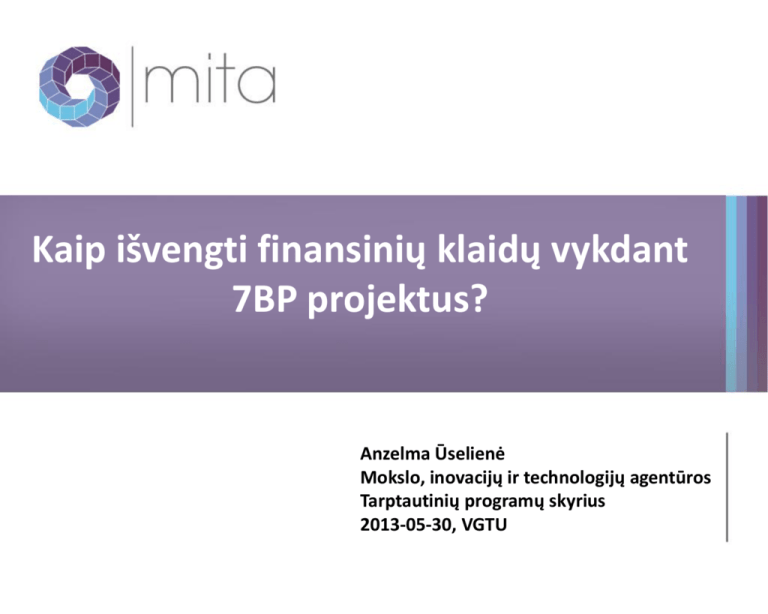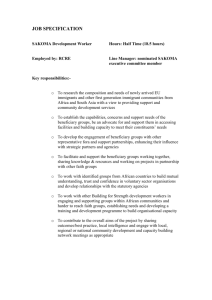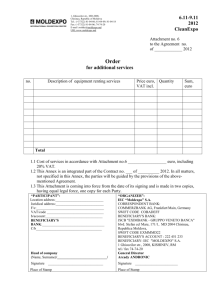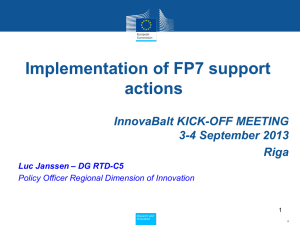Slide 10
advertisement

Kaip išvengti finansinių klaidų vykdant 7BP projektus? Anzelma Ūselienė Mokslo, inovacijų ir technologijų agentūros Tarptautinių programų skyrius 2013-05-30, VGTU Errors. Why do they occur? Misunderstandings of the rules; Lack of attention to the detail of the provisions of the FP7 grant agreements. The consequences of errors: Beneficiaries Non-optimal use of funding available Delayed payments Liquidated damages Recoveries Extrapolation Bankruptcy European Commission Scrutiny of the Budgetary Authority and ECA Increased error rate Increased ex post audit efforts Corrective measures Legal background The model Grant Agreement for the 7th Framework Programme (Annex II, Article 22.1) states that: “The Commission may, at any time during the implementation of the project and up to five years after the end of the project, arrange for financial audits to be carried out, by external auditors, or by the Commission services themselves including OLAF”.* “Such audits may cover financial, systemic and other aspects (such as accounting and management principles) relating to the proper execution of the grant agreement.” * European Anti-Fraud Office (OLAF) Audit findings 10 most common errors in FP7 1. Costs claimed that are not substantiated or are not linked to the project All costs claimed, with the exception of applicable lump sums and flat rates, should be based on the real costs incurred. Costs must be: • supported by evidence that they are real (recorded in the accounts of the beneficiary and supported by invoices for example) • paid (supported by bank statements for example) • linked to the funded project As a general rule, neither estimated amounts, nor budgeted amounts, are acceptable. 2. Third parties and sub-contracting •The use of third parties and/or sub-contractors should generally be identified during the negotiations of the project, and be set out in Annex I ("Description of Work") to the grant agreement. • If you wish to use third parties and/or sub-contractors that are not yet included in Annex I, you should send an amendment request through the project coordinator to the Commission service that signed the grant agreement • Subcontracting between partners of the consortium is not permitted under any circumstances • Costs for subcontracting and the costs of resources made available by third parties that are not used on the premises of the beneficiary cannot be used as a basis for calculating indirect costs. 3. Depreciation • If you purchase equipment for your project then you are not, in general, entitled to claim the full cost of the equipment immediately. • Rather, you are entitled to charge to the project the corresponding depreciation of the equipment over the part of its useful economic life that falls within the project. • You should use your usual depreciation policy. • only the part of the equipment dedicated to the project may be charged. For example, a beneficiary participates in a project that lasts for 3 years. In the second year of the project it acquires a machine that costs €100,000, and has a useful economic life of 5 years. The normal accounting policy of the beneficiary is to apply "straight line" depreciation. The eligible amount would be €40,000, reflecting the depreciation charge for the 2 remaining years until the end of the project. The residual value of €60,000 cannot be charged to the project since it falls outside the project's period. 4. Indirect cost models The FP7 indirect cost reporting methods are: - Actual indirect costs - Flat rates based on the real direct costs; 20%, 7% or 60% under limited circumstances. If you are unable to establish the actual costs then you should use a flat rate method If you use the "actual costs" reporting method, then this must be based on the real costs incurred, with evidence that they can be linked to the project. To use the actual indirect cost method, you need a Certificate of methodology. 5. Indirect costs - Ineligible costs included in the pool of indirect costs If you use the actual indirect costs model then the indirect costs must have a relationship with the eligible direct costs attributed to the project. The ineligible costs would include marketing and sales costs, financing costs, exchange rate losses, goodwill, etc; as well as those costs with no relationship to the project. In general, beneficiaries are reminded that eligible indirect costs accepted are those costs that cannot be identified as directly attributed to the project, but which can be proved to be incurred in direct relationship with the eligible direct costs attributed to the project. 6. Personnel costs - Calculation of productive hours The calculation of actual personnel costs requires the establishment of the productive hours for personnel. Productive hours should include all the time that the employee is available to undertake activities for the organisation. It should exclude weekends and holidays, but should include for instance teaching time, preparation of proposals, etc. As a guide, 1680 hours per year is considered to be a benchmark for productive hours. If your productive hours deviate from this benchmark the difference has to be substantiated. Productive hours may be different from "billable" hours. 7. Personnel costs - charging of hours worked on the project You must be able to produce evidence to support the number of hours that each person has worked on the project. This can be by the use of a reliable time recording system or adequate alternative evidence giving an equivalent level of assurance. The auditors have regularly identified time charged to the project while the staff member is on leave or attending conferences unrelated to the project, which puts into question the reliability of the time recording system as a whole. If timesheets are used, please ensure that they are completed in good time and are properly authorized. 8. Personnel costs - Use of average personnel costs It is now permitted to use average personnel costs for the calculation of staff costs under certain conditions. a. The average personnel cost methodology shall be the one declared by the beneficiary as its usual cost accounting practice; as such it shall be consistently applied to all indirect actions of the beneficiary under the FP b. The methodology shall be based on the actual personnel costs of the beneficiary as registered in its statutory accounts, without estimated or budgeted elements; c. The methodology shall exclude from the average personnel rates any ineligible cost item and any costs claimed under other costs categories in order to avoid double funding of the same costs; d. The number of productive hours used to calculate the average hourly rates shall correspond to the usual management practice of the beneficiary provided that it reflects the actual working standards of the beneficiary, in compliance with applicable national legislation, collective labour agreements and contracts and that it is based on auditable data. If you are unable to meet the criteria for the use of average personnel costs, you should declare real costs. 9. Payment of salaries to owner/managers of SMEs Under the FP7 rules SME owners may decide on whether or not to pay themselves a salary. SME owners who do not have a salary registered in the accounts should claim a flat rate payment based on the "Marie Curie" rates. Please note that, even if as an SME owner you are remunerated by means of dividends or withdrawals, you still need to charge "Marie Curie" flat rates. 10. VAT In the 7th Framework programme identifiable VAT, whether recoverable or not, is totally ineligible. Please ensure that VAT is always excluded from your cost claims. In Horizon 2020 VAT will probably be eligible. Daugiau informacijos Communication Campaign in Vilnius: http://www.mita.lt/lt/renginiai/agenturos_renginiai/kaip_isvengti_finansiniu_ klaidu_vykdant_7bp_projektus/ Note for beneficiaries in FP7: ftp://ftp.cordis.europa.eu/pub/fp7/docs/avoid-finance-errors-fp7-2012-0319_en.pdf Guide to Financial Issues: http://ec.europa.eu/research/participants/portal/ShowDoc/Extensions+Reposi tory/General+Documentation/Guidance+documents+for+FP7/Financial+issues/ financialguide_en.pdf National contact point: MITA International Programmes Division http://www.mita.lt/lt/kontaktai/ Dėkoju už dėmesį! Sekite mūsų naujienas www.mita.lt!






